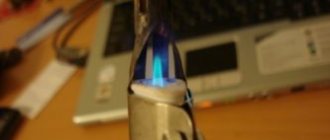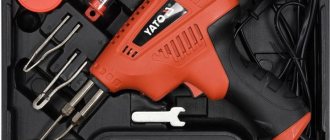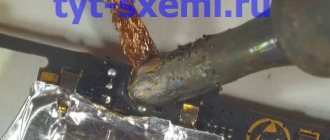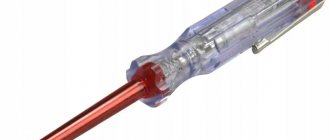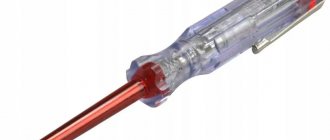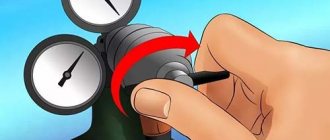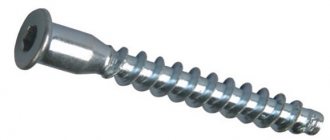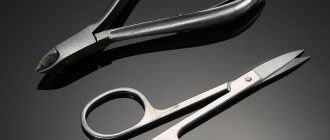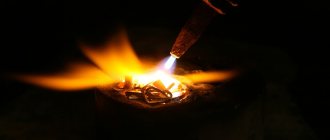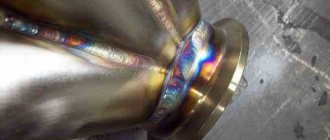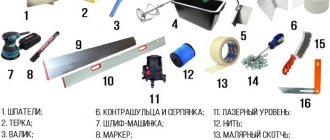Electronic microcircuits are installed not only in televisions and music centers. They are equipped with door locks and refrigerators, various drives and lighting devices. They perform the functions of microprocessors, memory, power supplies, and other devices. Current trends indicate a gradual expansion of the scope of their application. Therefore, a soldering iron for microcircuits is useful for equipping a modern personal workshop. With its help, you can quickly make repairs or upgrades, without resorting to the services of expensive specialists and other unnecessary costs.
In a large assortment of offers from specialized stores, it is not difficult to choose tools for successfully solving specific problems
Types of soldering irons
Soldering irons come with a ceramic or spiral heater. The difference is that ceramics heats up much faster, but requires more careful use: a strong blow will cause such a soldering iron to fail.
Spiral is not afraid of impacts, and it will last for many years. When choosing a soldering iron, you need to pay attention to its power. It is necessary to take into account that if you are soldering microcircuits, then it is advisable to choose a soldering iron with a nominal value of 10-20. Soldering irons rated above 60 W are designed for soldering thick wires.
A soldering iron with low power simply will not be able to melt the solder, since the power will be dissipated over a large soldering area. For soldering large metal parts, there are soldering irons from 100 watts and above. The most optimal soldering iron for a beginner is 25-40 W. This soldering iron is considered universal, and it can perform most tasks. Typically, radio amateurs have several soldering irons in their arsenal to cover a wide range of jobs.
Table of models of soldering irons for microcircuits.
In general sale, normal and reliable soldering irons for microcircuits are almost a rarity. If a person is engaged in repairing equipment professionally, he can purchase a suitable working tool. But he would rather choose a soldering station with all the necessary devices for soldering and the ability to set operating modes.
This is interesting! All about semiconductor diodes.
Soldering iron tip
Pay attention to the soldering iron tip. It comes in copper or nickel plated. A copper tip is better suited for soldering, as copper has high thermal conductivity. It can be cleaned with sandpaper or a file, but such a tip burns very quickly. Nickel is used in conjunction with a soldering iron, which has a temperature control, but its disadvantage is that the tip of this type cannot be cleaned with either a file or sandpaper.
After this treatment, the solder will no longer stick to the soldering iron. Quite a lot of people do not know about this feature of nickel tips, and after cleaning such a tip, soldering work turns into hell. The tip is a replaceable element with various types of fastening. Some soldering irons have a cap that is screwed on to secure the tip, while others have the tip secured with a screw.
The sting has a different shape. The soldering iron is sold with a universal tip already installed. They can do most jobs. There are stings as thin as a needle. They are intended for jewelry work involving soldering SMD components and are not capable of performing other tasks. Wide tips are designed for quick heating of the entire part and convenient installation/disassembly of the component.
Soldering iron tip soldering iron for microcircuits
Temperature adjustment
There are soldering irons with manual temperature control on the handle itself. This is an excellent thing for a radio amateur, since without this function there is always a chance of accidentally burning or overheating one or another component. If you overheat a radio component, it will lose its original properties and will work unstably, or even fail altogether.
The tip of a soldering iron tends to burn out during prolonged use. If your soldering iron does not have temperature control, be prepared to buy a new tip often. However, the disadvantages of such soldering irons include the inconvenient location of the handle adjustment and the not very reliable design.
Standalone devices
In addition to the types listed above, mention should be made of autonomous type devices, that is, those that can operate without being connected to an electrical outlet, these include:
- a gas soldering iron in which the tip is heated by the flame generated by the combustion of gas. In essence, this is an ordinary gas burner, which uses nozzles for soldering;
Gas type soldering device
- battery-powered soldering irons;
Mini soldering iron with independent power supply
Soldering Station
In addition to the soldering iron, you can purchase a hot air soldering station. This is a powerful tool in the hands of a radio amateur. This tool is equipped with temperature settings accurate to one degree. The soldering station has a convenient stand. Using such a device, you can solder not only small radio components, but also desolder entire microcircuits from boards using hot air.
It might be interesting➡ How to connect an ammeter to an AC or DC circuit
Soldering stations can significantly speed up your work. But to solder with such a station, experience is required. For beginners, there is no need for a soldering station at first. A simple soldering iron is enough to learn soldering skills. But once you get comfortable and confidently hold a soldering iron in your hand, you can think about more expensive equipment.
Soldering Station
Tools
When working on soldering circuits and wires, just having a soldering iron is not enough. For this type of installation, additional materials, tools and equipment will be required:
- Stand for the soldering iron itself. The temperature of the tip, even after completion of work, can be up to 300 degrees for some time. To protect surrounding people and objects from burns, there must be a stand. If you don’t want to spend money on it, you can easily make it yourself.
- Solder. It is an alloy of tin and lead, which is needed for contact with the surface.
- Rosin. Essentially, it is a solid resin that is used to remove oxide films and grease layers from surfaces.
You may be interested in Magnetic generators operating without fuel
Important: you should not breathe vapors or smoke from solder and rosin, as this has a negative effect on the human body.
- Tweezers. Used for working with small radio components. It is best to take a tool whose ends are pointed.
- Side cutters. Mainly useful for working with wire and for stripping wires.
- File. It is used to file off the soldering iron tip if necessary.
- Screwdrivers. It’s better to buy a whole set with different attachments at once.
Fluxes: basis for soldering in radio electronics
As a rule, a radio amateur has many different chemicals in his arsenal, which allows him to create the highest quality and reliable solder. Fluxes are special chemicals intended for radio installation. It allows you to remove oxide films and allows the solder to spread evenly. Fluxes are divided into several types: neutral, active and anti-corrosion.
Neutral fluxes
Neutral are the most popular, simple and safe fluxes. They do not contain acids or other aggressive elements that cause corrosion of metals, and generally do not require rinsing. Rosin, the cheapest type of flux, is a must-have for every radio amateur. It protects the surface from oxides and prevents corrosion. We can say that this is a universal type of flux.
LTI 120 is a liquid flux, classified as neutral. It contains no acids, which means it will not corrode metal. The basis of its composition is rosin dissolved in alcohol. LTI-120 is easy to use: you just need to apply a layer of flux to the surface to be soldered, and then solder the desired element to the board.
On sale you can also find gel fluxes based on rosin. They are very convenient for soldering when you only need to apply a small amount of flux to a specific area. Typically, neutral fluxes do not require rinsing, however, many hams prefer to rinse off any flux after use.
Active fluxes
Active (also called acid) fluxes contain hydrochloric, phosphoric or citric acid. After using them, it is necessary to wash the part, since flux residues will cause corrosion and corrode the soldering. These fluxes mainly remove aggressive substances from soldered parts.
The most popular flux of this type is soldering acid. It can be used to solder, for example, nickel alloys. F38N is used for soldering resistant corrosion steel, various copper alloys, bronze, nichrome and brass. Residues of F38N can be easily washed off with water.
Other types
There are also anti-corrosion fluxes consisting of phosphoric acid. They do not cause corrosion of ferrous metals, which means there is no need to remove flux residues after soldering. For non-ferrous metals, rinsing with warm water is recommended. In addition to water, fluxes can be washed off with acetone, nephrase, ethyl or isopropyl alcohol. All of these products are suitable for cleaning printed circuit boards.
There are also solder pastes, which are a mixture of flux and solder. It happens that such pasta is made independently. You just need to use a file to make shavings from solder and mix it with liquid fluxes. This paste can be applied to the part and then warmed up the soldering iron. It can be used when soldering surface-mounted installations or used in hard-to-reach places on the board.
Table of solders for soldering irons for microcircuits.
Interesting read: what is electric current?
Requirements for soldering irons for soldering radio components
To choose a high-quality soldering iron for specific purposes, you need to take into account all the features of the chosen direction. Working with microcircuits is somewhat different from soldering pipes, wires and various contacts. All this is displayed on the tool that is required to perform this procedure.
Different types of soldering iron tips
When considering options for which soldering iron to choose for soldering radio components for beginners, you should pay attention to the following requirements:
- Shape of the sting. When working with radio engineering and electronics parts, you need a soldering iron to have a conical tip. This form is best suited for working with small contacts. Thanks to this approach, it is much easier for the master to desolder microcircuits and solder them in the right place, which are the main operations using this tool.
- Tip material. It is best to choose ceramic models, as they help protect sensitive products from static voltage. Copper varieties are also used and are quite practical, but you have to work with them more carefully. Ceramic blades are easier to clean and get ready for use faster.
- Power regulator. When considering which soldering iron is best to choose, you should pay attention to modern models with a power regulator. This allows you to select the necessary characteristics of the tool for a specific type of work. Thanks to this, you can perform many types of procedures with one soldering iron.
- Compact size. Small models are much easier to control when working with microcircuits. Thick tips, even if they have the desired shape, will not allow for delicate work. Accordingly, a small, lightweight model with a fine tip would be an excellent choice.
- Availability of additional buttons. Buttons for increasing the soldering temperature, which are found on pulse models, as well as in other varieties. They help save energy when working.
Various models of soldering irons
Design
Soldering irons for microcircuits have a number of differences:
- The tip of the soldering iron is called the tip. This is the main working part. From it, or more precisely from its shape and size, it is determined for what specific purposes this or that device serves.
- Another factor by which you can recognize this type of soldering tool is the size of the device itself. Small jobs require a soldering iron that is compact, lightweight, and easy to control. Standard devices are too crude for this.
- The power of a soldering iron for soldering microcircuits is also quite low. This is to ensure that the tip does not reach too high a temperature. This may harm circuit components.
Soldering iron design
What can a soldering iron be useful for?
There are many areas of application for this high-tech device. Here is a partial list of tasks, in which you will probably find your own recurring problems.
- Soldering wires and repairing electrical extension cords;
- Soldering and replacement of radio components in household appliances;
- Repair of lamps and LED lamps;
- Repair of thin-walled metal pipe connections;
- Repair of leaky metal tanks and containers;
- Quickly burns holes in plastic;
- Cutting off excess parts in plastic parts and housings;
- And so on.
It will be interesting➡ The design of an ammeter and the principle of its operation
As can be seen from this list, there is always a use for a soldering iron, as long as your hands are fairly straight. And in some cases, the simplest and most inexpensive soldering iron will do, as long as the power is sufficient, for example, 60 W.
It is perfect for soldering wires. But for “electronic” tasks it is better not to overdo it with power, because The tracks on the boards do not like too high temperatures and easily peel off, and the radio components themselves fail. Below we will tell you which soldering iron to choose for soldering radio components. When choosing a soldering iron, you should decide for what purpose you need this electric tool.
Additional tips and insights
It’s not difficult to buy an electric soldering iron for microcircuits using this article. But we must not forget about the proper equipment of the workplace:
- The table covering must be resistant to high temperatures.
- Good lighting will help you perform the most complex operations accurately.
- Good ventilation is useful to remove fumes.
- It is convenient to store small electronic components and consumables in suitable sized boxes.
- Large instruments are placed in cabinets.
Set for convenient soldering: magnifying glass, holders with alligator clips, backlight, spring stand
It is easier to work with miniature parts using a microscope and displaying an enlarged image on a computer screen
Characteristics
Technical characteristics that you should pay attention to when choosing a tool:
- Power. In the case of soldering irons for circuits, the power value should not exceed 10 W. This parameter affects the performance and safety of electrical elements. This approach is used when installing a circuit. If elements are being removed from the board and their safety is not important, then a high power value will facilitate the process.
Powerful devices can only be used by experienced radio amateurs who are able to perform work accurately and quickly without causing overheating of the elements.
Devices of various power
- The voltage required to operate. High voltage from the network, equal to 220 V, can also damage parts. For this reason, the soldering iron is connected through a step-down transformer, which, depending on the model, produces either 12 or 36 V. When choosing a product, it is best to take a kit that already includes a transformer or power supply, so as not to purchase it separately.
- The thickness of the tip also plays an important role. For conventional instruments it is about 5 mm. For micro-soldering tools, a value of up to 3 mm is considered normal. Replacement tips are most often sold separately, but there are kits that also include them.
- Soldering tool
- Along with a soldering iron, it is a good idea to purchase various accessories and tools. If you once worked with a good tool, then you are unlikely to want to work with a bad one. Therefore, it is better to buy a good tool once than to buy a bad one several times.
- For soldering you will need the following tools:
- – small wire cutters – for wires, parts leads and stripping of insulation,
- – file – for cleaning the soldering iron tip,
- - tweezers - so as not to burn your fingers,
- – medical scalpel or stationery knife,
- – a syringe needle with a blunt tip,
- - thin awl.
- As you gain experience in repairing and manufacturing electronic circuits, this arsenal of yours will gradually expand and modify.
- How to organize a soldering workspace
- A good workshop, and especially a set of tools, takes years to create. Moreover, when mastery comes, purchased instruments no longer meet our requirements; we have to make instruments with our own hands. But for this you need to have not only a workplace, but also the appropriate equipment.
- A workshop is needed not only for working with electronic devices and structures, but also for general household work. Modern apartments, as a rule, do not leave us the opportunity to equip our workplace in a separate room, so we can use any free corner. Attaching shelves to the wall, planning the corner and lower cabinet is a matter of your imagination and skill.
- To place the tool, you can use strips with permanent magnets or a homemade set of magnetic door latches. On the surface of the table, equip a special field covered with asbestos - for working with a soldering iron, acids and solvents.
- For particularly small parts for one purpose, use plastic boxes for cacti, glued (fastened) into a typesetting box. Or buy special containers at a specialty store. For medium-sized parts, rectangular sour cream boxes are well suited; they have very comfortable sides that fit well into specially cut grooves. Microchips, in addition to standard plastic boxes, can be conveniently stored in sheets of foam inserted into a shoe box.
- The cabinets at the top and bottom can accommodate spare parts, an electric drill (small drilling machine), LATR, various files, a jigsaw, a small hand drill, various containers with varnishes, adhesives, solvents and ferric chloride. Set aside a special place for measuring instruments, place separately a small vice with an anvil, a large vice, etc.
- Make sure to have a container with low sides and a large enough area for debris - bitten off leads and removed braiding. A plastic disposable plate is very suitable for such waste (do not touch it with the tip of a heated soldering iron!).
- Power supply and lighting of the workplace
- It is imperative to provide local lighting for the workplace. Previously, we published an article on our website with instructions for making a powerful table lamp. See: DIY Timeless Table Lamp. This lamp is ideal for performing small jobs with a lot of eye strain.
- The light should fall on the board so that the hand with the soldering iron does not cover it. The power supply panel in the laboratory must provide: adjustable direct voltage (rectified) and alternating voltage 0 - 250 V (LATR), power for the soldering iron and any necessary direct current voltage to power any electronic structures.
Gas soldering iron
Low voltage device made from a ballpoint pen
To make a soldering iron you will need the following attributes:
- stationery pen;
- MLT type resistor;
- a piece of double-sided PCB;
- steel wire (d=0.5 mm);
- copper wire with diameter (d=1 mm).
Algorithm of actions
- First of all, remove the paint layer from the surface of the MLT-0.5 resistor. A razor blade or kitchen knife is suitable for this. If the paint does not want to peel off, then you can connect the element to a power source and warm it up slightly.
- Prepare a cylindrical barrel. One wire coming out of it is cut off. In this place a hole is drilled for the copper wire. It must be remembered that contact of the wire with the cup is unacceptable, so countersinking is done with a drill with a large diameter. After this, a small cut is made for the conductive rod on the MLT cup.
- A small ring is formed from steel wire, the diameter corresponding to the cut on the MLT.
- A board is cut out of a piece of textolite. Its dimensions are calculated based on the size of the ballpoint pen and the available wire.
- All nodes are brought together. A thin tip is installed in the seating area. You need to be extremely careful not to accidentally burn the miniature structure. A protective layer is made from mica. Thanks to it, the copper wire will not burn through the resistor.
- Check the homemade device by connecting it to the electrical network using a regular 1 A power supply. The voltage must not exceed 15 V.
How much does a soldering iron for microcircuits cost in stores and online?
This type of tool is quite difficult to find on sale. Tips are most often sold for conventional soldering irons, which can also be used to solder microcircuits. But if you want to purchase a separate device for these tasks, then look better and you will see that they are still on sale. The cost of such devices starts from 300 rubles, for very simple devices for home and infrequent use, and can reach about 6-8 thousand rubles for equipment designed for professional use.
It might be interesting➡ How to connect an ammeter to an AC or DC circuit
Whether to choose a ready-made soldering iron for microcircuits or to make one yourself is up to everyone to decide for themselves. Sometimes it is enough to change the tip in your existing soldering iron to a thinner one or a more convenient shape. Any job requires its own tool, and the work of dismantling or installing microcircuits requires a special soldering iron, which in skillful hands will ensure high-quality contact of the microcircuit with the board tracks, and cleanliness, beauty and, most importantly, normal operation of the installed device.
